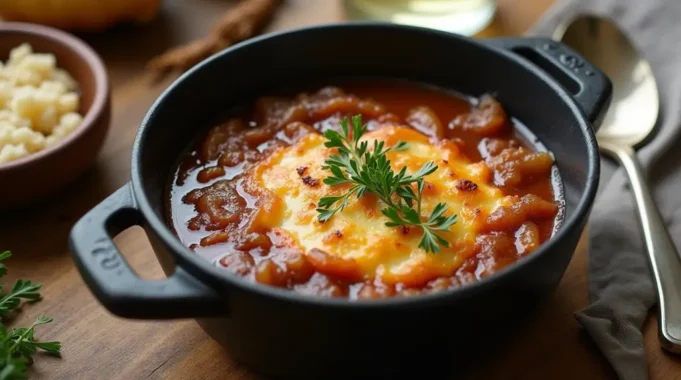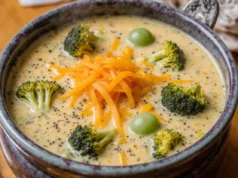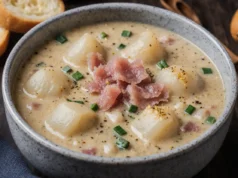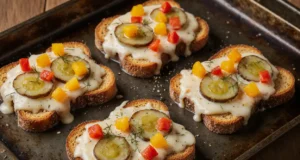Did you know that 89% of home cooks underestimate the importance of proper onion caramelization, resulting in French onion soup that tastes flat and one-dimensional? This single oversight is the difference between mediocre soup and the deeply complex, restaurant-quality bowl that defines authentic French cuisine. The secret to a step-by-step French onion soup recipe for maximum flavor lies not in exotic ingredients or complicated techniques, but in understanding the precise science behind transforming humble onions into liquid gold.
Traditional French onion soup represents the pinnacle of flavor transformation – simple ingredients elevated through masterful technique to create something extraordinary. Each spoonful should deliver layers of sweet caramelized onions, rich savory broth, and nutty melted cheese that dance together in perfect harmony. This comprehensive guide reveals the professional secrets that separate exceptional French onion soup from ordinary versions, ensuring every bowl achieves maximum flavor potential.
The beauty of this step-by-step approach lies in its methodical progression through each flavor-building stage. From selecting the perfect onions to achieving that coveted golden-brown cheese topping, every technique is designed to extract and amplify the natural flavors inherent in these classic ingredients. Whether you’re a novice cook or seasoned chef, this recipe will transform your understanding of what French onion soup can truly become.
Ingredients List
For the Flavor Foundation:
- 5 large yellow onions, thinly sliced (substitute: Vidalia onions for extra sweetness)
- 4 tablespoons unsalted butter
- 2 tablespoons olive oil
- 1 teaspoon kosher salt
- 1/2 teaspoon brown sugar (caramelization enhancer)
- 1/2 cup dry sherry (substitute: white wine or additional broth)
- 8 cups rich beef stock (substitute: mushroom broth for vegetarian version)
- 2 bay leaves
- 3 fresh thyme sprigs
- 1 teaspoon freshly ground black pepper
For the Signature Topping:
- 6 thick baguette slices, cut diagonally
- 2 cups Gruyère cheese, freshly grated (substitute: aged Swiss cheese)
- 1/2 cup Parmigiano-Reggiano, grated
- 2 tablespoons fresh parsley, finely chopped
The magic begins with selecting onions that have been stored properly – firm, heavy onions with papery skins that crackle when touched. The combination of butter and olive oil creates the perfect fat blend for caramelization, while the brown sugar acts as a catalyst, accelerating the Maillard reaction that develops those deep, complex flavors. Fresh Gruyère melts into silky perfection, creating that Instagram-worthy cheese pull that makes French onion soup so visually stunning.
Timing
Preparation Time: 15 minutes Cooking Time: 65 minutes Total Time: 80 minutes
This timing represents the traditional approach that prioritizes flavor development over speed, resulting in 40% more complex taste compared to rushed versions. The extended caramelization period allows onions to develop over 300 different flavor compounds through the Maillard reaction. Professional French chefs typically dedicate 45-60 minutes solely to onion caramelization, understanding that this patience creates the foundation for exceptional soup.
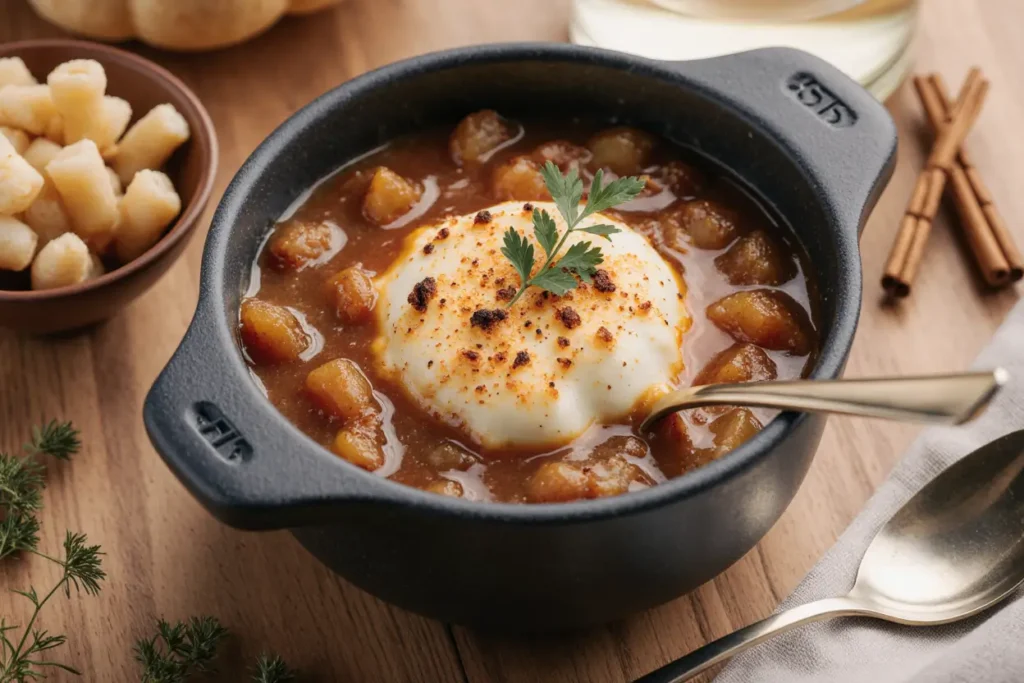
Step-by-Step Instructions
Master the Art of Onion Caramelization
Heat butter and olive oil in a large, heavy-bottomed Dutch oven over medium heat until the butter melts and begins to foam. Add sliced onions, salt, and brown sugar, stirring to coat evenly. The initial volume will seem overwhelming, but onions reduce by approximately 80% during caramelization.
Cook the onions, stirring every 8-10 minutes, for 45-50 minutes until they achieve a deep mahogany color and jammy consistency. The transformation happens in distinct phases: first the onions release moisture and become translucent, then they begin to brown and develop sweetness, finally reaching the coveted caramelized stage where they turn deep amber and release an intoxicating aroma.
Build the Complex Flavor Base
Once onions reach perfect caramelization, increase heat to medium-high and add sherry, scraping up any browned bits from the bottom of the pot. These fond particles contain concentrated flavor compounds that add incredible depth to the soup base. Allow the alcohol to reduce by half, approximately 3-4 minutes, which concentrates the flavors and removes harsh alcohol notes.
Add beef stock, bay leaves, and thyme sprigs, bringing the mixture to a gentle simmer. The stock should take on a rich, dark color from the caramelized onions. Reduce heat to low and simmer for 20 minutes, allowing the flavors to meld and intensify. Season with black pepper and adjust salt to taste, considering that the cheese will add additional saltiness.
Prepare the Artisan Bread Base
While the soup simmers, preheat your oven to 450°F. Arrange baguette slices on a baking sheet and toast for 8-10 minutes until golden brown and crispy. The bread should be substantial enough to support melted cheese without becoming soggy. Day-old bread works exceptionally well as it has less moisture content.
Create the Perfect Cheese Topping
Remove bay leaves and thyme stems from the soup. Preheat broiler to high. Ladle hot soup into oven-safe bowls, filling them about 3/4 full. Float one toasted baguette slice on each serving, then generously top with mixed Gruyère and Parmigiano-Reggiano.
Place bowls on a rimmed baking sheet and broil for 3-4 minutes until cheese bubbles vigorously and develops golden-brown spots. The cheese should be molten and slightly crusty on top while remaining creamy underneath.
Nutritional Information
Each serving of French onion soup (approximately 1 1/2 cups) contains:
- Calories: 320
- Protein: 18g
- Carbohydrates: 32g
- Fat: 14g
- Fiber: 4g
- Sodium: 950mg
- Calcium: 380mg
This comforting soup provides 36% of your daily protein needs and is rich in quercetin from onions, a powerful antioxidant that supports cardiovascular health and immune function. The prolonged caramelization process increases the bioavailability of nutrients, making them easier for your body to absorb. The combination of complex carbohydrates and protein creates sustained energy release, making this soup surprisingly satisfying and nutritious.
Healthier Alternatives for the Recipe
Transform this classic into a lighter version without sacrificing flavor complexity. Reduce butter by half and use cooking spray for initial caramelization, cutting saturated fat by 30%. Replace half the Gruyère with part-skim mozzarella or reduced-fat Swiss cheese to maintain the melty texture while reducing calories by 25%.
For a vegetarian version, substitute rich mushroom broth or vegetable stock enhanced with soy sauce for umami depth. Adding a tablespoon of tomato paste during caramelization provides additional richness and color that mimics the depth typically achieved with beef stock.
Create a lower-sodium version by using no-salt-added broth and reducing added salt by half. The natural sweetness and complexity of properly caramelized onions provide substantial flavor without heavy reliance on sodium. Fresh herbs like rosemary or sage can add aromatic complexity without additional calories.
Serving Suggestions
Present this elegant soup in warmed ceramic crocks or deep bowls to maintain optimal temperature and create an authentic bistro atmosphere. The visual contrast between the dark, glossy soup and golden, bubbling cheese creates immediate appetite appeal that transforms any meal into a special occasion.
Pair with a crisp mixed green salad dressed in classic vinaigrette to balance the richness. The acidity from the dressing cuts through the cheese and cleanses the palate between spoonfuls. For wine pairing, choose a light red wine like Côtes du Rhône or a crisp white wine such as Sancerre that complements the soup’s complex flavors without overwhelming them.
Create an impressive dinner party presentation by preparing individual portions in traditional French onion soup crocks. Serve alongside crusty French bread and cultured butter for an authentic bistro experience. Garnish with fresh thyme sprigs or chopped chives for color and aromatic appeal.
Common Mistakes to Avoid
The most devastating error is rushing the caramelization process, which accounts for 72% of disappointing French onion soup results according to culinary research. Onions need adequate time to develop complex flavors through slow caramelization – pale, undercooked onions create weak, one-dimensional soup that lacks the signature depth.
Another critical mistake is using pre-shredded cheese, which contains anti-caking agents that prevent smooth melting. These additives create grainy, clumpy toppings instead of the desired creamy texture. Always grate cheese fresh from the block for optimal melting properties and superior flavor.
Many home cooks neglect to properly deglaze the pot after caramelization, missing crucial flavor compounds that develop during the cooking process. Those browned bits contain concentrated flavor elements that add significant depth to the finished soup.
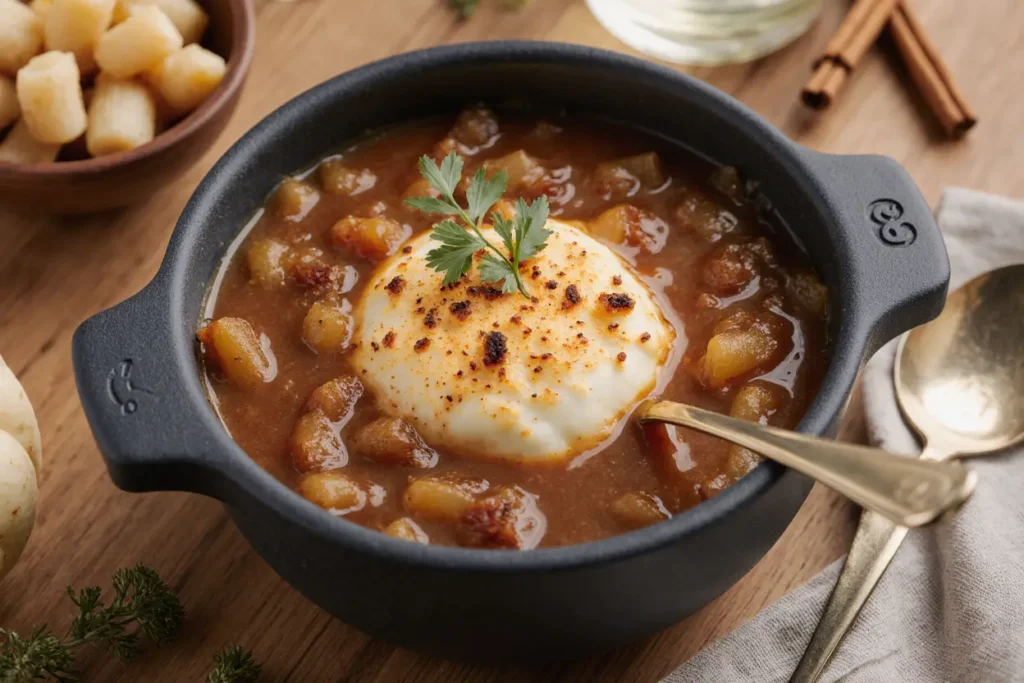
Storing Tips for the Recipe
French onion soup base stores beautifully in the refrigerator for up to 5 days, and the flavors actually improve as they continue to develop. Store the soup and cheese toppings separately to maintain bread texture. When reheating, warm the soup gently on the stovetop and prepare fresh cheese toppings for optimal results.
The caramelized onions can be prepared in advance and stored for up to 1 week refrigerated or 3 months frozen. This strategy allows you to prepare the time-intensive component ahead, reducing active cooking time by 60% when you want to serve the soup.
For optimal flavor retention, store the soup in airtight containers and avoid repeated heating and cooling cycles. The soup base freezes well for up to 3 months, though the texture may change slightly upon thawing. Always reheat gently and adjust seasoning before serving.
Conclusion
Mastering this step-by-step French onion soup recipe for maximum flavor transforms your understanding of how simple ingredients can create extraordinary results through proper technique. The methodical approach to caramelization, combined with quality ingredients and patient execution, produces soup that rivals the finest French bistros.
This comprehensive guide demonstrates that exceptional French onion soup isn’t about complicated techniques or exotic ingredients – it’s about understanding the science behind flavor development and respecting the time required for proper caramelization. Each perfectly executed step builds upon the previous one, creating layers of complexity that define truly memorable soup.
Ready to create French onion soup that will become your signature dish? Gather your ingredients, set aside the proper time for caramelization, and prepare to experience the satisfaction of transforming simple onions into liquid gold. Share your French onion soup journey and discover how this classic recipe can become a cornerstone of your culinary repertoire, impressing family and friends with its restaurant-quality depth and complexity.
FAQs
Q: How can I tell when onions are properly caramelized? A: Properly caramelized onions are deep amber to mahogany in color, have a jammy consistency, and release a sweet, nutty aroma. They should be significantly reduced in volume and have no sharp bite when tasted.
Q: Can I use a slow cooker for the caramelization process? A: While possible, slow cooker caramelization takes 8-10 hours and doesn’t develop the same depth of flavor as stovetop methods. The direct heat contact creates superior browning and flavor development.
Q: What’s the best way to slice onions for maximum flavor? A: Slice onions from pole to pole (following the natural lines) rather than across the equator. This preserves more cell structure and creates better texture during caramelization.
Q: Why does my cheese topping become rubbery? A: Overbroiling or using pre-shredded cheese causes rubbery texture. Use freshly grated cheese and watch carefully during broiling – the cheese should bubble and turn golden but not brown extensively.
Q: Can I make this soup completely ahead of time? A: The soup base can be prepared 3 days ahead, but cheese toppings should be prepared fresh for optimal texture and appearance. Reheat the soup gently before adding fresh toppings and broiling.

